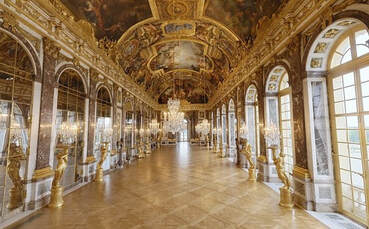
From the Versailles parquet panels synonymous with the palace of the very same name, to the chevron pattern parquet wood flooring to be found within many a modern interior, parquetry boasts an association with elegance and style that is hard to beat. When entering a room with a parquet floor, the impact is instant – and as impressive today as it ever has been. One might wonder, how did the practice of parquetry come about? Here, we will delve into the origins of this spectacular form of flooring, and uncover why it remains so immensely popular as a choice for interiors today.
A Cutting Edge Development Within 16th Century France
Prior to the arrival of Versailles parquet panels, the mansions and châteaus of France – and indeed much of the rest of the world – were floored with quarry cut marble or stone. Installed over wooden joists, such costly floors were an eternal maintenance challenge, as their weight and the need for wet washing would take its toll upon the timber frames beneath. However, innovation was to lead to a brand new fashion for flooring in 16thCentury France. A new form of mosaic-style wooden flooring was about to take the country by storm – and then Europe, and the world.
Initially, wooden blocks were glued to concrete floors, however a more sophisticated technique was on the horizon. The new practice of parquet de menuiserie (woodwork parquet) saw blocks composed into panels, held together by a cutting-edge tongue and groove design. Such a method allowed the creation of marvellously intricate floors, featuring decorative pattern, and even colour variation thanks to the availability of diverse and stunning hardwoods. As such, the art of parquetry was born. This new form of flooring was opulent in appearance, hard wearing, and far easier to maintain than its stonework counterpart. Its name was derived from the Old French parchet, meaning a small enclosed space, and it was to become a prominent feature of French interiors over the next century.
Of course, it was the palace of Versailles that was to elevate this style of flooring to international notoriety. A revolution in French interior design was about to begin, and it was to create an allure that would make the nation’s aesthetic one of universal aspiration.
Captivation Within The Palace Of Versailles
King Louis XIV oversaw construction of the Palace of Versailles in 1682, on a site that had once been inhabited by a modest hunting lodge. This new construction was to exhibit a scale of decadence never seen before – and hardly challenged since. From endless gilt work to solid silver furnishings, everywhere the eye could be cast was populated with the greatest fineries. Beneath these many monuments to wealth was the consistent visual element of parquetry – the spectacular shine and intricate grain of the finest woodwork.
Almost every room of the palace was laid with Versailles parquet panels. This particular form of parquet can be immediately recognised by its distinct square pattern, set on a diagonal to the space it inhabits. From its introduction within the great palace to its place within modern interior design, the Versailles floor motif has remained tied by name to this fascinating moment in French history.
One room of the palace, however, deviated in design, featuring a different form of parquetry all together – the Queen’s Guard room. Within this lavish chamber, chevron pattern parquet wood flooring was chosen. This single room marked the beginning of an interior aesthetic that enjoys particular demand today, more than 300 years after its first inception. Chevron parquet flooring, beside herringbone parquet, can be noted as parquetry form of choice for the current Millennium. Returning to the Palace of Versailles, upon its completion, King Louis XIV moved the entire French Court to this new home of grandeur, where it would remain until the French Revolution began in 1789.
Post time: Nov-17-2022

